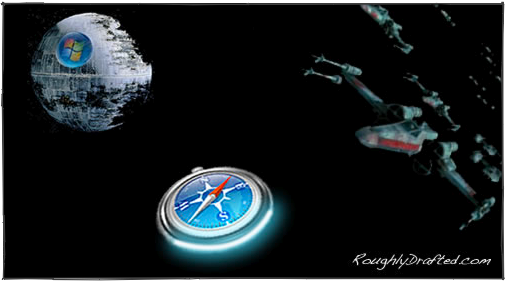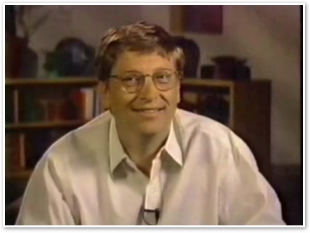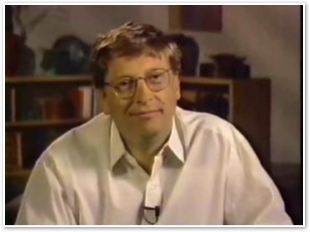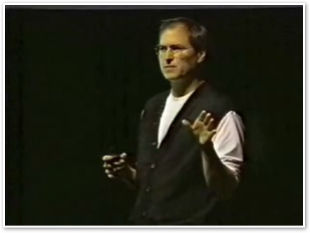

2007 - Apple Strikes Back
In the tech world, a lot can happen in ten years.
Ten years ago, Apple was in no position to do much of anything. Today, Apple wields so much influence in online media markets that some Europeans want to socialize music to give more control to the mostly European music labels. Here’s how things changed so dramatically, and how Apple’s new firepower relates to Microsoft.
Ten Years Ago At Apple: Bad News
In February of 1997, Apple was about to release the Newton MessagePad 2000, the G3 processor hadn't yet appeared, and System 7 had just been renamed Mac OS with the release of version 7.6 at Macworld in January.
As a company, Apple was in rough shape. It reported an $816 million loss for 1996, and sales going forward appeared bleak. There many reasons why Apple was bleeding.
Products: Throughout the early 90s, CEOs John Sculley and Michael Spindler had launched a confusing product lineup of faux-Latin sounding Mac model names and numbers that could only be described as Sony-esque: Performa 6118CD, Centris 650av, Quadra 630.
Sales: Plans to expand retail sales at Sears were in meltdown, and efforts to license the Mac and Newton both had disappointing results. Apple had stuffed the channel with inventory to create the illusion that Mac sales weren't in trouble, but all those Performas were now rotting in warehouses while Apple paid their rent.
Software: The Mac's system software had grown stagnant and many big third party developers were churning out third rate software for the Mac, notably Macromedia. 

PARCing: Apple itself had stopped making useful products it could sell, and had instead turned into a think tank for other companies to shake down for ideas.
In the same manner that many raw technology discoveries at Xerox PARC had ended up leaving Xerox to find applications at Adobe, Cisco, Apple, and Microsoft, Apple's own Advanced Technology Group--while having delivered the technology behind QuickTime, AppleScript, and V-Twin searching--was largely inventing ideas that were rapidly leaving Apple to enrich other companies. Among them:
-
•technology behind WebTV, which was acquired by Microsoft for $425 million to create MSN TV
-
•sponsorship of NCSA Mosaic, which spun off SpyGlass, licensed by Microsoft for Internet Explorer
-
•the Paradigm project, which was spun off as General Magic and licensed its technology to Microsoft for WinCE
The Good News
There was a glimmer of hope left: Apple had just acquired NeXT, and brought back a founder who cared about delivering interesting products. While Steve Jobs had seen scant profits from his efforts to build NeXT computers and later sell NeXT software, his return to Apple at least suggested a real stab at turning the company around, rather than simply trying to dress it up to sell off to the highest bidder.
Dell Computer's Michael Dell said at the time that, were he in Jobs place, he'd shut the company down and give the proceeds back to its shareholders. Fortunately for Apple, Jobs was more than just a discount salesman.
Jobs had lead efforts to deliver one of the most pivotal products in personal computing: the Macintosh. He'd also used his own personal fortune to assemble a team of masterminds to develop NeXT, and had bought up the CGI arm of Lucasfilm and turned it into Pixar.
Jobs' Reluctance to Save Apple
During the first half of 1997, Jobs appeared only half heartedly interested in the remains of Apple. Jobs had already largely given up on NeXT, with Pixar consuming most of his attention. 

Pixar had just released its first feature film in 1995, Toy Story, and was preparing to release A Bug's Life in 1998. Both were wildly successful and critically acclaimed, while Apple Computer was plagued with the beleaguered tag, and few people even remembered what NeXT was.
"People keep trying to suck me in. They want me to be some kind of Superman. But I have no desire to run Apple Computer. I deny it at every turn, but nobody believes me," Jobs said at the time.
Maybe I’ll Take a Look
Job did have some ideas for Apple however. Within days of NeXT's acquisition by Apple, then CEO Gil Amelio gave a long winded overview at Macworld Expo of how he planned to use NeXT technology to shore up the Mac.
What he struggled to get out was based on advice from Jobs. It involved killing the boondoggle of OpenDoc and replacing the core Mac System Software with NeXT's modern operating system.
Jobs also insisted that Apple had to materially rethink its licensing plans for cloners and get rid of its Chief Operating Officer Marco Landi and chief technologist Ellen Hancock, who Jobs reportedly called a "bozo."
He also wanted to dismantle the Advanced Technology Group, which hadn't produced a salable product for years, even under its fancy new name, the Apple Research Labs.
Within months, Apple’s board convinced Jobs to sign up as the interim CEO for Apple, and paid Amelio millions of severance to leave.
"For Apple to win, Apple has to do a really good job"
Shortly after taking the reigns of Apple, Jobs presented a new partnership with Microsoft at the summer 1997 Macworld Expo in Boston. It included:
-
•a cross licensing agreement
-
•a five year deal for continued development of Office for the Mac platform
-
•the designation of Internet Explorer as the default Mac web browser
-
•a small but symbolic $150 million investment by Microsoft in Apple
The announcements were booed by many of Apple's customers in attendance. When Bill Gates appeared on the ominously large video screen via satellite, attendees booed so loudly the audio was cut out so that Gates comments could be heard. The event is almost painfully sad to watch.
"Some of the most exciting work that I've done in my career has been the work that I've done with Steve on the Macintosh," Gates said with an uncomfortable smile.
He announced the development of Office 98 for the Mac adding, "And I think it's going to really set a new benchmark for doing a good job with performance, and exploiting unique Mac features. In many ways it's more advanced than what we've done on the Windows platform."
Gates concluded by saying, "We think Apple makes a huge contribution to the computer industry. We think it's going to be a lot of fun helping out, and we look forward to the feedback from all of you as we move forward doing more Macintosh software."
The applause afterward was mixed with more booing, but Jobs didn't appear to relish Mac users' contempt for Gates. Instead, Jobs said, "You know, where we are right now, is we're shepherding some of the greatest assets in the computer industry. And if we want to move forward, and see Apple healthy and prospering again, we have to let go of a few things here. We have to let go of this notion that for Apple to win Microsoft has to lose."
"We have to embrace a notion that for Apple to win, Apple has to do a really good job. And if others are going to help us, that's great, because we need all the help we can get. And if we screw up and we don't do a good job, it's not somebody else's fault. It's our fault."
"I think if we want Microsoft Office on the Mac, we better treat the company that puts it out with a little bit of gratitude. We'd like their software. So the era of setting this up as a competition between Apple and Microsoft is over as far as I'm concerned. This is about getting Apple healthy, and this is about Apple being able to make incredibly great contributions to the industry, to get healthy and prosper again."
How Apple Got Healthy Again
Earlier articles have detailed some of the changes made at Apple after Jobs was handed control of the company by its board of directors in the summer of 1997:
-
•Why Apple Bounced Back detailed how it found new markets for Macs by developing or acquiring software.
-
•Apple's Retail Challenge detailed how Apple started its own direct online Apple Store in the model of Dell's.
-
•Apple's Adventures in Retail detailed how Apple started its own chain of retail outlets to sell Macs.
Jobs’ Apple began rapidly creating products that could be sold:
-
•The existing mess of Mac models and numbers were replaced with the Power Mac G3 and the PowerBook G3.
-
•The Newton MessagePad was revised, but after sales failed to materialize, it was quickly abandoned.
-
•The iMac was released the next spring in 1998, and in 1999 it was joined by the iBook consumer laptop.
Every year since, Apple released revised new Macs. In 1999 it debuted AirPort wireless networking, in 2001 it announced the iPod, and in 2002 the Xserve.
It's the Software
While Apple's reversal of fortune was funded by hardware sales, it was software that really clinched the deal.
Without investing huge amounts of money into the development of Mac OS X, Mac sales wouldn't have rebounded. Mac OS X's Unix foundation attracted many Linux and open source developers. It also created a platform capable of really taking advantage of the hardware, and allowed Apple to move to Intel in 2006.
First party application development provided low cost, high quality software that did little to enrich Apple directly, but did a lot to spur sales of new Macs. Pro Apps also sell Cinema Displays, Xserves, and Xserve RAID hardware.
Software also sells the iPod, which gains many of its differentiating benefits from its integration with iTunes.
Had Apple instead tried to create a reference platform for the iPod and sell it to Creative, Samsung, and others, it would likely have failed for some of the same reasons Microsoft did with PlaysForSure: it's simply really hard to herd cats, particularly since hardware makers have different motivations than software makers.
To Do it Right, Do It Yourself
The result has been a vindication of Apple's basic strategy all along: to build its own high quality, integrated products, rather than license out software and reference designs as Microsoft has. Many analysts still refuse to realize this, but in time they will as it becomes even more obvious:
-
•Mac OS X, tightly integrated with Mac hardware, offers many advantages over Vista on a generic PC. If Microsoft built its own Vista PC, it would have certain advantages over Vista running on a third party PC. Apple's Mac goes even further.
-
•iTunes, tightly integrated with the iPod, offers many advantages over Windows Media and PlaysForSure players. Microsoft's own Zune offered certain advantages over Windows Media running on third party PlaysForSure players. Apple's iPod goes even further.
-
•Obviously, I also believe that the iPhone, with its tightly integrated apps and integration with iTunes, will offer advantages over Windows Mobile, Palm OS, Symbian, Linux, and the smartphones that run them. Microsoft's rumored Zune Phone might be better than the Samsung BlackJack or Motorola Q, but the iPhone goes further.
Hold the Phone
However, despite my own personal ideas on the iPhone--which I believe will be as pivotal to mobile phones as the Mac was to PCs in 1984--it's not the product category that I described in the last article as the Microsoft mainstay Apple is "targeting with a missile that may cause far more damage than the iPod and iTunes together."
Microsoft doesn't even make any money in mobiles.
Instead, I have rather unintentionally created another Empire Strikes Back article by setting up too much back-story to deploy my real plot, forcing my intended sequel into a trilogy.
The next article will indeed point out how Apple is digging into its past to resurrect a long scuttled product concept. The difference this time around is that it will be powered by something far more lethal and dangerous than it was the first time around. And I believe Microsoft will not like it at all.
Bonus points for guessing what it is (the product or the fearsome technology that powers it).
Next Articles:
This Series


 |
|
 |
|
 Del.icio.us |
Del.icio.us |
 Technorati |
About RDM :
:
Technorati |
About RDM :
:

Thursday, February 8, 2007







 Send Link
Send Link Reddit
Reddit NewsTrust
NewsTrust






